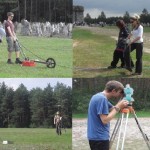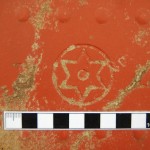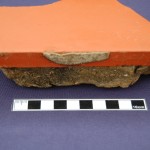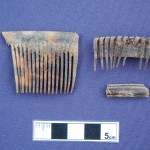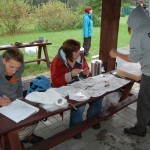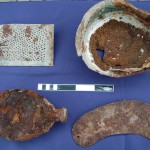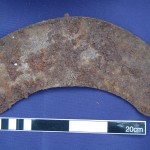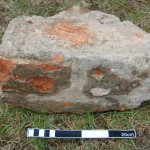Extermination Camp (Treblinka II)
Over the course of several field seasons, the landscape of the extermination camp has been investigated using a number techniques, facilitating a re-interpretation of the site:
- Interviews with survivors and witnesses have been undertaken and a large body of archival material has been collated.
- Through integrated field survey and the correlation of aerial images and LiDAR data, the current marked camp boundary has been shown to be incorrectly located. Thus, the camp appears to have been considerably larger than previously thought and this has implications for the existence of features relating to the Living Camp part of the site (part of which is currently located in a forested area outside of the marked camp boundary).
- Non-invasive geophysical survey has allowed the location of a number of mass graves and cremation pits to be determined in the extermination camp. These areas were then avoided during more invasive work so as to comply with Jewish Halacha Law. These graves will hopefully be marked in the future.
- Targeted topographic and geophysical survey across the site has helped to identify the locations of key structures and features associated with the operation of the camp including the Lazarett, railway platform (which was substantially larger than the symbolic platform that is present), the Tyrolean Guard Tower, waste pits, and the camp entrance.
- Targeted excavations were carried out in 2013 in order to confirm the nature of some of the structures identified in the geophysical survey results. Deep sand and rubble deposits were identified in specific areas of the site. This material appears to have been levelled across the former death camp area, likely in an attempt by the Nazis to hide their crimes. Earlier evidence was identified beneath these deposits, including in situ structural remains.
- An apparent structure measuring 22 x 15m was identified in the Ground Penetrating Radar survey, undertaken in 2010. Targeted excavation in the middle of this area in 2013 confirmed that this structure was the Old Gas Chamber building. The discovery of tiles, sections of wall and other building furnishings proved that this building was modelled on a bathhouse. The tiles found were manufactured by Dziewulski i Lange.
- Further evidence of a structure was identified in the geophysical survey results, across an area measuring 44 x 20m.
- An important assemblage of artefacts has been recovered from the test pit excavations and walkover survey. These artefacts include personal effects, building materials, tiles, domestic utensils, and military artefacts. The finds are currently under specialist analysis and conservation, and represent an important assemblage that will enhance our understanding of the site.
- Geophysical survey and targeted test pits at Treblinka II have demonstrated the complexity of the buried environment and the considerable disturbance that was present across the entire site.
- Cremated and non-cremated human remains were located on the surface of the extermination camp area and also during the excavations. These remains were scattered remains, not buried in mass graves. All of these remains were reinterred by a representative from the Office of the Chief Rabbi of Poland.
- Working at Treblinka II using geophysical and topographic survey methods
- Tiles from the old gas chamber at Treblinka II
- Tiles from the old gas chamber
- A brooch found near the old gas chamber at Treblinka II
- Tiles from the old gas chamber with cement
- Some of the many hair clips found near the old gas chambers at Treblinka II
- Examining the artifacts found during the investigation at Treblinka
- Artifacts found on the surface in the area of the SS Living Camp at Treblinka II
- A metal plaque found in the SS Living Camp Area at Treblinka II
- Artifacts found on the surface in the area of the SS Living Camp at Treblinka II
- One of the many tiles found in the area of the old gas chamber at Treblinka II
- One of the sections of brick wall found in the area of the old gas chamber at Treblinka II
- Structural remains of the old gas chamber buried beneath approximately 1m of demolition rubble and artifacts.
Read about the results of the survey at Treblinka I (the labour camp) and the Execution Site
The Finding Treblinka project was documented as part of a Channel 5 television programme, Treblinka: Inside Hitler’s Secret Death Camp, (produced by Furneaux and Edgar Productions) which was aired in November 2013 in the UK and March 2014 in the USA.
The work at Treblinka is ongoing. The team have since returned to Treblinka several times. More information regarding the fieldwork and research at Treblinka can be found by visiting the links below and through Professor Caroline Sturdy Colls’ publication page. Fieldwork carried out in 2017 as part of the HERA funded iC-ACCESS project, included continued excavations at the site of the gas chambers and of the camp waste pits, as well as an extensive photogrammetric survey. The use of 3D technologies at Treblinka is further discussed in Dr Dante Abate and Professor Caroline Sturdy Colls’ paper ‘A multi-level and multi-sensor documentation approach of the Treblinka extermination and labor camps’ available on Science Direct.
The full results of the research are published in various journal articles and in Sturdy Colls, C. (In Prep.) Finding Treblinka. Archaeological Investigations at Treblinka Extermination and Labour Camps [In English and Polish] in 2014.
Some of the publications pertaining to the work carried out at Treblinka include the following:
Sturdy Colls, C. 2015. Finding Treblinka: An Exhibition of Forensic Archaeological Research. Exhibition Catalogue. Stoke-on-Trent: Staffordshire University.
Sturdy Colls, C. and Branthwaite, M. 2017. ‘This is proof”? Forensic evidence and ambiguous material culture at Treblinka extermination camp’. International Journal of Historical Archaeology 23. DOI 10.1007/s10761-017-0432-3. View article
Sturdy Colls, C. 2015. Mapping Nazi Terror: Archaeological Investigations at Treblinka Extermination and Labour Camps. Proceedings of the Archaeology of Violence: Archaeology of War, Archaeology of Mass Violence Conference, France. [In French] Sturdy Colls, C. 2016. Une cartographie de la terreur nazie : études archéologiques dans les camps de travail et d’extermination de Treblinka. In: Guilaine, J. and Semelin, J. Violences de guerre, violences de masse. Une approche archéologique. Paris: Le Decouverte.
Sturdy Colls, C. 2014. ‘Gone but not forgotten: Archaeological approaches to the landscape of the former extermination camp at Treblinka, Poland’, Holocaust Studies and Materials 3. Available as an e-book Gone but not forgotten.
Sturdy Colls, C. 2012. O tym, co minelo, lecz nie zostalo zapomniane. Badania archeologiczne na terenie bylego obozu zaglady w Treblince. Zaglada Zydow. Studia i Materialy 8 (in Polish), 77-112. For more information see: http://www.zagladazydow.org/?l=a&lang=pl
To learn more about Professor Caroline Sturdy Colls and the work she has carried out, visit her profile page.

